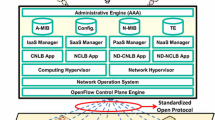Abstract
In this paper different algorithms are presented and evaluated for designing Virtual Private/Overlay Network (VPNs/VONs) over any network that supports resource partitioning e.g. ATM (Asynchronous Transfer Mode), MPLS (Multi Protocol Label Switching), or SDH/SONET (Synchronous Digital Hierarchy/Synchronous Optical Networking). All algorithms incorporate protection as well. The VPNs/VONs are formed by full mesh demand sets between VPN/VON endpoints. The service demands of VPNs/VONs are characterized by the bandwidth requirements of node-pairs (pipe-model).
We investigated four design modes with three pro-active path based shared protection path algorithms and four heuristics to calculate the pairs of paths. The design mode determines the means of traffic concentration. The protection path algorithms use Dijkstra’s shortest path calculation with different edge weights. The demands are routed one-by-one, therefore the order in which they are processed matters.
To eliminate this factor we used three heuristics (simulated allocation, simulated annealing, threshold accepting). We present numerical results obtained by simulation regarding the required total amount of capacity, the number of reserved edges, and the average length of paths.
Similar content being viewed by others
References
B. Józsa and D. Orincsay, Shared backup path optimization in telecommunication networks, Design Of Reliable Communication Networks, DRCN 2001, Budapest, Hungary.
S. Yuan and J. P. Jue, A heuristic routing algorithm for shared protection in connection-oriented network, Proceedings, SPIE OptiComm 2001, Vol. 4599, Denver, CO, pp. 142–152, August 2001.
P.-H. Ho and H. T. Mouftah, A framework for service-guaranteed shared protection in WDM mesh networks, IEEE Communications Magazine, pp. 97–103, Feb. 2002.
P.-H. Ho and H. T. Mouftah, Allocation of protection domains in dynamic WDM mesh networks, 10th IEEE International Conference on Network Protocols (ICNP 2002), 12–15 November 2002, Paris, France, pp. 188–189.
Y. Liu, D. Tipper, and P. Siripongwutikorn, Approximating optimal spare capacity allocation by successive survivable routing, IEEE Infocom2001, 22–26 April 2001.
G. Li, D. Wang, C. Kalmanek, and R. Doverspike, Efficient distributed path selection for shared restoration connections, IEEE Infocom2002, June 2002, New York.
A. Al-Rumaih, D. Tipper, Y. Liu, and B. A. Norman, Spare capacity planning for survivable mesh networks, Proceedings IFIP-TC6, Networking 2000, May 14–19, Paris, France.
M. Kodialam and T. Lakshman, Dynamic routing of bandwidth guaranteed tunnels with restoration, IEEE Infocom2002, March 2000, Tel-Aviv, Israel.
J. De Clercq and O. Paridaens, Scalability implications of virtual private networks, IEEE Communications Magazine, May 2002.
T. Cinkler and M. Maliosz, Configuration of protected virtual private networks, Design of Reliable Communication Networks, DRCN 2001, Budapest, Hungary.
M. Pióro, T. J. K. Stidsen, A. J. Glenstrup, C. Fenger, and H. Christiansen, Design problems in robust optical networks, Networks 2000, Toronto, Canada, 10–15 September 2000.
A. J. Glenstrup, Optimized Design and Analysis of All-Optical Networks, PhD Thesis, Research Center COM, Technical University of Denmark, Denmark, May 2002.
Kirkpatrick, S., Gerlatt, C. D., Jr., and Vecchi, M. P., Optimization by simulated annealing, Science, Vol. 220, pp. 671–680, 1983.
Author information
Authors and Affiliations
Corresponding author
Additional information
Péter Hegyi received MSc (2004) degree from the Budapest University of Technology and Economics, Hungary, where he is currently a PhD student at the Department of Telecommunications and Media Informatics. His research interests focus on design of intra- and inter-domain multilayer grooming networks and routing with protection. He has been involved in a few related projects (IKTA, ETIK, NOBEL).
Markosz Maliosz is a researcher in the High Speed Networks Laboratory, Department of Telecommunication and Media Informatics at the Budapest University of Technology and Economics, where he received his MSc degree in Computer Science (1998). He has participated in projects concerning telecommunication services, network device control, Voice and Video over IP. His current research areas are Virtual Private Networking and traffic engineering in optical networks.
Ákos Ladányi is a student at the Department of Telecommunications and Media Informatics at the Budapest University of Technology and Economics. His research interests focus on routing, network resilience, and combinatorial optimization.
Tibor Cinkler has received MSc(‘94) and PhD(‘99) degrees from the Budapest University of Technology and Economics, Hungary, where he is currently Associate Professor at the Department of Telecommunications and Media Informatics. His research interests focus on routing, design, configuration, dimensioning and resilience of IP,MPLS, ATM, ngSDH and particularly of WR-DWDMbased multilayer networks. He is the author of over 60 refereed scientific publications and of 3 patents.
Rights and permissions
About this article
Cite this article
Hegyi, P., Maliosz, M., Ladányi, Á. et al. Virtual Private/Overlay Network Design With Traffic Concentration and Shared Protection. J Netw Syst Manage 13, 119–138 (2005). https://doi.org/10.1007/s10922-005-1865-2
Issue Date:
DOI: https://doi.org/10.1007/s10922-005-1865-2




